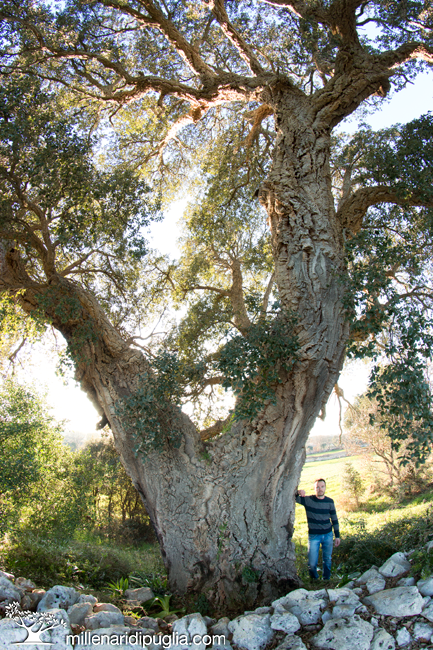
The Cork Oak of Ostuni
This post is also available in:
 Italiano (Italian)
Italiano (Italian)
The cork oak of Ostuni is one of the largest Quercus suber in southern Italy.
Ostuni, also known as the “White City” due to its historic centre originally painted with white lime, is located in the province of Brindisi, on the southern Murgia Plateau and on the border with Salento.
Puglia is a region very rich in monumental trees: not only centuries-old and millenary olive trees but also many other species. For example, there are some oaks of particular interest such as holm oaks, downy oaks or the famous Mount Tabor oak of Tricase, known as “the oak of the hundred knights”.
It’s a priceless natural heritage that can make the locals extremely proud. Many of those natural monuments, as we have repeatedly experienced, are almost completely unknown and yet only through more and more prominent exposure we may guarantee their acknowledgement and protection as natural assets.
The special “Millenari di Puglia” project has given “voice” to several centuries-old olive trees, truly unique in the world and featuring humongous sizes (some of them are more than 2.000-year old) but the abovementioned project has also recognized many other trees, just as noteworthy. In our case, it is the largest cork oak in Puglia we’re talking about, and located in Ostuni, a few miles from the so-called “white city”
The trunk of this magnificent specimen reaches a circumference of 18.37 ft while soaring to a height of 4.26 ft. It’s a real giant, as well as a wondrous but unfortunately little known natural monument. It truly bears the signs of time, showing black traces of burns on its bark: still, Mother Nature is bolder and stronger than many damages caused by man.
In Italy, there’s the Sicilian specimen of Niscemi (Caltanissetta), known as the “Mosaic cork”, and several remarkable specimens in Sardinia. The largest cork oak in Italy is most likely the specimen which grows in the Castelporziano estate (Rome), which measures more than 182 ft in circumference.
The history of the Cork Oak of Ostuni is quite interesting. The local climatic conditions are ideal for the Quercus suber which needs more rainy areas. Even the soil, made of limestone and with a basic pH, does not adapt well to the needs of this tree which requires a more acidic substrate. Yet, this beautiful oak thrives in this very part of Puglia, in the limestone plain where olive trees are abundant.
It was probably brought here in the past to obtain cork, a particularly useful and interesting material. It was used, for instance, by the Romans for the construction of buoys or sandals. Moreover, it was used to seal the oil amphoras shipped to distant destinations and for the construction of ships. In all likelihood, it was the Romans who made the first attempts to reproduce and select this plant in a place that was not that suitable for the cork oak.
We do not know if anyone else had tried before to grow genetically suitable acorns in this part of Italy. Still, we can now admire this great cork oak which is also part of the historical heritage of Puglia and Italy.
Quercus suber
– biology and ecology
The cork is a long-lived plant that grows in temperate climates and with moderate rainfall, on fresh, deep and loose soils, originating from the decay of acid substrates, such as granite, schist, and trachyte. It does not tolerate frosts: for example, in Sardinia it grows at average temperatures between 55.4 F° and 64.4 F°, up to a maximum height of 2.624-2.952 ft.
– distribution
Like a typical Mediterranean species, it is mostly found in the Iberian Peninsula, France and northern Africa. In Italy, it mainly grows in Sardinia, Sicily, on the Tyrrhenian coastline, and in Puglia.
– Importance and use
The cork oak is a native species, cultivated for the production of cork in a limited area of the western Mediterranean basin. Its looks grey and spongy, while the average 2-inch bark can be removed from plants at least 15-20-year old.
“De-barking” is carried out by incision, paying particular attention to avoid injury to the underneath tissue. The first extraction is called “de-tapping” and the first result is called “male cork” because it is very coarse, rough, cracked and porous; the following extractions, which take place at intervals of 9-12 years, offer “gentle” or “female cork”, due to the lightness, compactness and homogeneity of the material.
To avoid damage to the plant, the best period for extraction is between May and August.
This post is also available in:
 Italiano (Italian)
Italiano (Italian)
Contatti
72017 Ostuni(BR)
